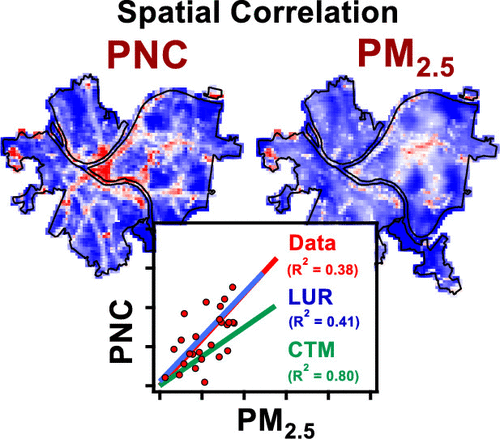当前位置:
X-MOL 学术
›
Environ. Sci. Technol.
›
论文详情
Our official English website, www.x-mol.net, welcomes your feedback! (Note: you will need to create a separate account there.)
Spatial Correlation of Ultrafine Particle Number and Fine Particle Mass at Urban Scales: Implications for Health Assessment.
Environmental Science & Technology ( IF 11.4 ) Pub Date : 2020-06-30 , DOI: 10.1021/acs.est.0c02763 Provat K Saha 1, 2 , Shayak Sengupta 1, 3 , Peter Adams 1, 3, 4 , Allen L Robinson 1, 2, 3 , Albert A Presto 1, 2
Environmental Science & Technology ( IF 11.4 ) Pub Date : 2020-06-30 , DOI: 10.1021/acs.est.0c02763 Provat K Saha 1, 2 , Shayak Sengupta 1, 3 , Peter Adams 1, 3, 4 , Allen L Robinson 1, 2, 3 , Albert A Presto 1, 2
Affiliation

|
The epidemiological evidence for ultrafine particles (UFP; particles with diameter <100 nm) causing chronic health effects independent of fine particulate matter (PM2.5) mass is inconclusive. A prevailing view is that urban UFP and PM2.5 mass have different spatial patterns, which should allow epidemiological studies to distinguish their independent, chronic health effects. We investigate intraurban spatial correlation of PM2.5 and UFP exposures in Pittsburgh, Pennsylvania. Measurements and predictions of a land-use regression model indicate moderate spatial correlation between particle number concentrations (PNC; a proxy for UFP) and PM2.5 (R2 of 0.38 and 0.41, respectively). High-resolution (1-km) chemical transport model simulations predict stronger spatial correlation (R2 ≈ 0.8). The finding of moderate to strong spatial correlation was initially surprising because secondary aerosol contributes the vast majority of PM2.5 mass. However, intraurban spatial patterns of both PNC and PM2.5 are driven by local emissions and both pollutants largely behave as passive tracers at time scales of 1 day or less required for transport across most urban environments. Although previous research has shown little temporal correlation between PNC and PM2.5, our finding of moderate to strong spatial correlation may complicate epidemiological analyses to separate the chronic health effects of PNC from PM2.5 mass.
中文翻译:

城市规模的超细颗粒数量与细颗粒质量的空间相关性:对健康评估的意义。
关于超细颗粒(UFP;直径<100 nm的颗粒)引起慢性健康影响的流行病学证据尚无定论,这与细小颗粒物质(PM 2.5)无关。普遍的看法是,城市UFP和PM 2.5的质量具有不同的空间格局,这应允许流行病学研究区分其独立的慢性健康影响。我们调查宾夕法尼亚州匹兹堡的PM 2.5和UFP暴露的城市内部空间相关性。土地利用回归模型的测量和预测表明,颗粒物浓度(PNC; UFP的替代物)和PM 2.5(R 2分别为0.38和0.41)。高分辨率(1公里)的化学品运输模型模拟预测更强的空间相关性(- [R 2 ≈0.8)。起初令人惊讶的是发现了中等至强烈的空间相关性,因为次级气溶胶占了PM 2.5质量的绝大部分。但是,PNC和PM 2.5的城市内部空间格局都是由局部排放驱动的,并且在大多数城市环境中运输所需的1天或更短的时间内,两种污染物在很大程度上都充当被动示踪剂。尽管先前的研究表明PNC和PM 2.5之间的时间相关性很小,我们发现中度到强空间相关性可能会使流行病学分析复杂化,从而将PNC的慢性健康影响与PM 2.5质量区分开。
更新日期:2020-08-04
中文翻译:

城市规模的超细颗粒数量与细颗粒质量的空间相关性:对健康评估的意义。
关于超细颗粒(UFP;直径<100 nm的颗粒)引起慢性健康影响的流行病学证据尚无定论,这与细小颗粒物质(PM 2.5)无关。普遍的看法是,城市UFP和PM 2.5的质量具有不同的空间格局,这应允许流行病学研究区分其独立的慢性健康影响。我们调查宾夕法尼亚州匹兹堡的PM 2.5和UFP暴露的城市内部空间相关性。土地利用回归模型的测量和预测表明,颗粒物浓度(PNC; UFP的替代物)和PM 2.5(R 2分别为0.38和0.41)。高分辨率(1公里)的化学品运输模型模拟预测更强的空间相关性(- [R 2 ≈0.8)。起初令人惊讶的是发现了中等至强烈的空间相关性,因为次级气溶胶占了PM 2.5质量的绝大部分。但是,PNC和PM 2.5的城市内部空间格局都是由局部排放驱动的,并且在大多数城市环境中运输所需的1天或更短的时间内,两种污染物在很大程度上都充当被动示踪剂。尽管先前的研究表明PNC和PM 2.5之间的时间相关性很小,我们发现中度到强空间相关性可能会使流行病学分析复杂化,从而将PNC的慢性健康影响与PM 2.5质量区分开。


























 京公网安备 11010802027423号
京公网安备 11010802027423号